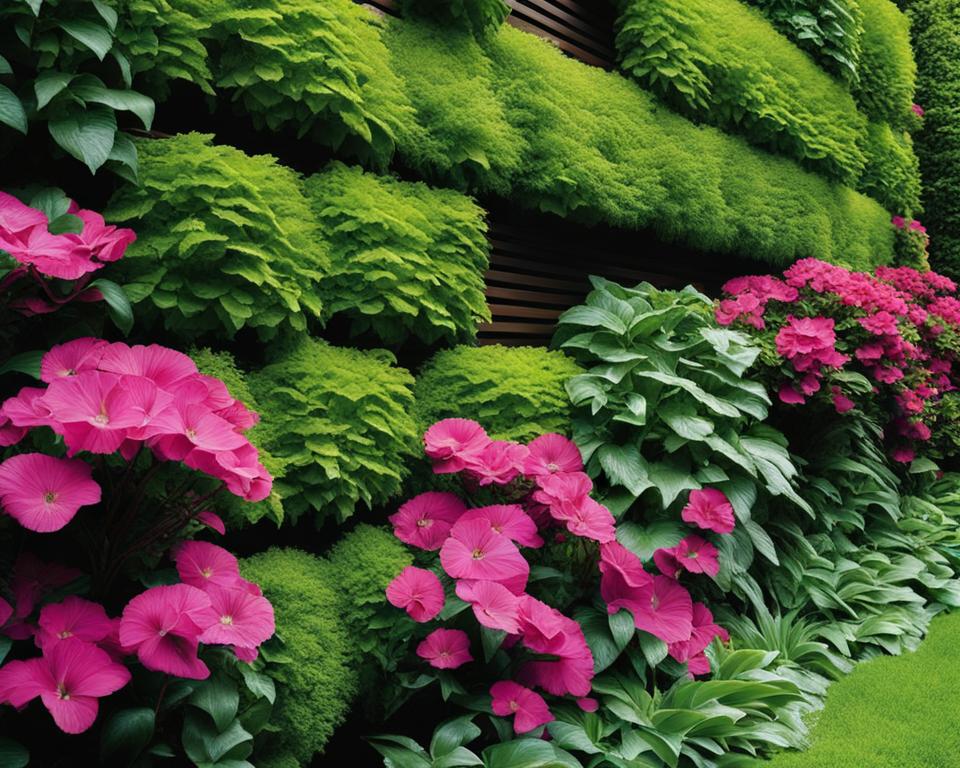Imagine transforming your living space into a vibrant oasis with vertical gardening plants. This innovative approach to gardening invites you to rethink the potential of your indoor and outdoor areas. Whether you’re looking to enhance the ambiance of your home or optimize limited spaces in urban settings, vertical gardens offer lush growth without the sprawl. The benefits of vertical gardening extend beyond the aesthetic appeal, contributing to air purification, humidity control, and creating a sense of serenity in increasingly concrete-dominated environments.
With vertical gardening design, you’re not only investing in a visually stunning feature but are also engaging with a greener, more sustainable form of living. Lush living walls can be simple to maintain and suit a range of plants, from flowering beauties to edible herbs and vegetables. Embrace the vertical gardening trend, and turn any wall into a living piece of art that grows with you.
Key Takeaways
- Vertical gardening plants can flourish in both indoor and outdoor settings, creating eye-catching displays.
- Discover the ecological and health benefits of vertical gardening, which improves air quality and adds humidity.
- Learn how a well-planned vertical garden design can revolutionize even the smallest urban spaces.
- Understand the aesthetic and environmental importance of integrating lush living walls into your space.
- Explore how vertical gardening extends beyond ornamentation by offering practical solutions for fresh produce.
- Acknowledge the ease and viability of growing an array of plants vertically, regardless of your gardening experience.
The Basics of Vertical Gardening
Embarking on the journey of vertical gardening requires a foundational understanding of its core principles and practicalities. This revolutionary method of cultivating flora on vertical surfaces not only saves space but also brings a dynamic element to both indoor and outdoor environments. Below, you’ll find critical vertical gardening tips and techniques that will assist in creating your very own lush green wall.
Understanding Vertical Garden Structures
Vertical gardening structures are as varied as the plant species they support. From rustic wooden trellises to sleek metal frames, the possibilities are nearly endless. Choosing the appropriate structure is crucial to the success of your garden, as it affects the health and growth of your plants. Your choice may range from wall-mounted vertical garden pots to innovative hanging systems, each with its own aesthetic and functional benefits.
Here are a few popular structures to consider:
- Wooden, metal, or plastic trellises are ideal for vines and climbing plants.
- Freestanding towers or columns can accommodate multiple plant types without wall support.
- For tight spaces, consider using stackable vertical garden pots, which can easily be rearranged.
- Harnessing recycled materials for your vertical garden contributes to sustainability and uniqueness.
Best Spots for Your Vertical Garden Setup
Finding the perfect spot for your vertical garden is more than just choosing a random wall. You must consider factors like sunlight exposure, ease of access for maintenance, and the visual impact you want to achieve. Utilize vertical gardening ideas to transform bland facades into lively focal points, or to cover unsightly elements with vibrant plants.
Tips for choosing the best spot include:
- Observing light patterns throughout the day to ensure plants receive optimal sunlight.
- Considering the view from inside your home to enjoy the greenery from within.
- Using vertical gardens to create privacy screens or natural partitions in your outdoor space.
Seasonal Care for Indoor and Outdoor Vertical Gardens
Caring for your vertical garden varies with the seasons. Whether indoors or outdoors, these living walls need attention to watering, exposure to sunlight, and protection against the elements.
Seasonal care tips:
- During the warm seasons, increase watering frequency to combat rapid soil drying.
- In colder months, protect your outdoor vertical gardens with insulating materials or bring delicate plants indoors.
- Periodically rotate plants to ensure they receive even lighting and grow uniformly.
Maintaining the health of your vertical garden is an ongoing process, but the stunning visual payoff is well worth it. Apply these insights and let your vertical gardening project flourish, creating a verdant retreat in your own home or urban space.
Vertical Gardening Systems and Techniques
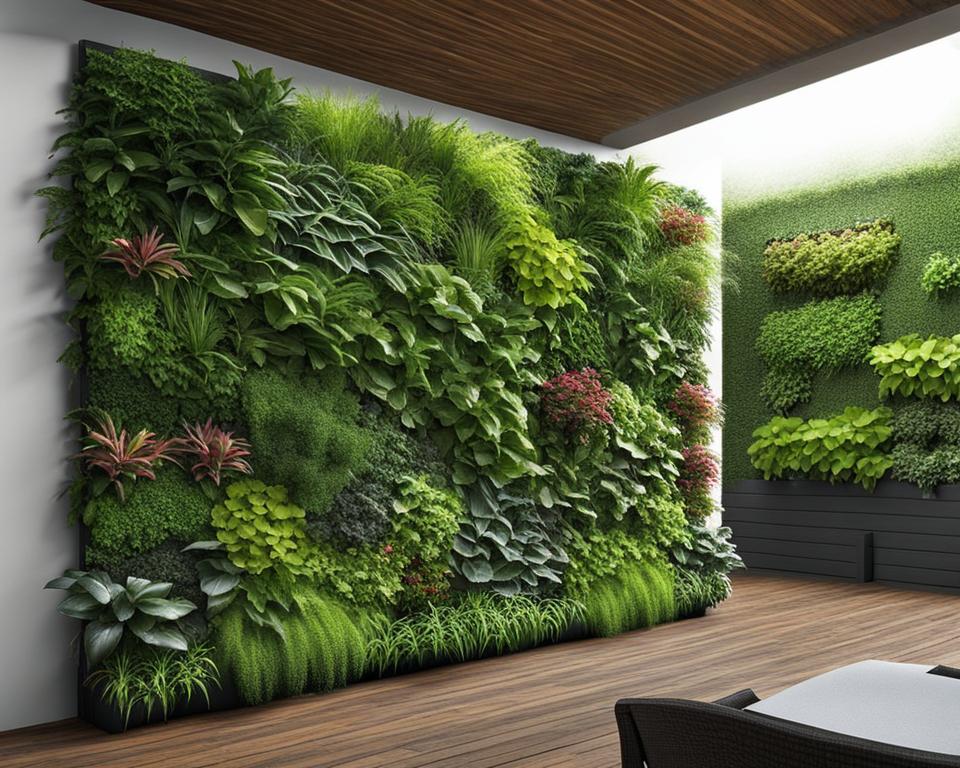
As urban populations grow and outdoor space becomes ever more precious, the green wall movement has sparked a widespread interest in vertical gardening systems. These innovative structures provide not only a lush aesthetic appeal but also contribute to the wellness of our environment. From simplistic trellis set-ups to high-tech hydroponic installations, each system offers a unique way to integrate nature into our daily lives, acting as living walls that breathe life into concrete landscapes.
Choosing the Right Vertical Gardening System
When setting out to create your own living wall, it’s essential to select a gardening system that aligns with your space, budget, and the types of plants you wish to cultivate. Renowned botanist Patrick Blanc’s technique, which utilizes metal framing, rigid plastic, and felt, is perfect for those seeking a system that supports a wide range of plant species without the use of soil. Conversely, simpler systems may utilize soilless potting mediums that are easier to install and maintain, ideal for beginner gardeners or those with smaller spaces. The right system will provide the necessary support and environment for your plants to thrive vertically.
Implementing Efficient Watering Solutions
Water management is a key component of a successful vertical garden. Due to gravity, water can rapidly run through the system, meaning that vertical gardening systems often require more frequent watering than their horizontal counterparts. Some modern systems come with built-in irrigation, streamlining the watering process and ensuring every plant receives the hydration it needs. Whether you opt for a drip irrigation system, a manual watering schedule, or self-watering containers, it is vital that you keep the unique water requirements of your plants in mind.
Maintenance Tips for Vertical Gardening Systems
Maintaining a bountiful vertical garden entails more than just watering. Regular pruning helps to control growth and maintain the garden’s aesthetics, while dusting and weeding ensure your plants stay healthy. Occasionally, it may be necessary to replace certain plants to preserve the overall vitality of your living wall. It’s also recommended to engage a structural expert before installation to ensure that your chosen wall can support the weight of the garden, especially if you’re incorporating more advanced, heavier systems. With these tips, your vertical garden will become a dynamic part of your living or working space.
Best Plants for Vertical Gardening
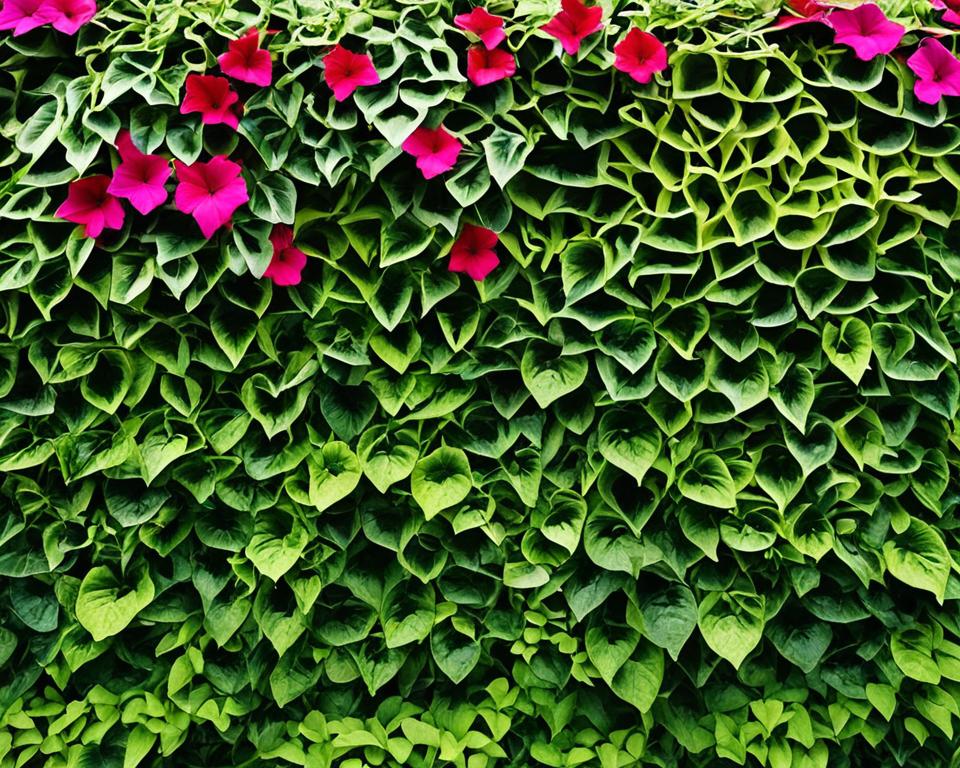
Understanding the best plants for vertical gardening can transform your space into a thriving, green oasis. Whether you’re seeking to create a vertical plant wall or integrate vertical garden vegetables into your culinary landscape, the selection of plants is crucial to your garden’s success. Here are some top recommendations to ensure your vertical garden flourishes in any light condition.
For those sunlit spaces, vivacious annual vines such as the black-eyed Susan vine and moonflower come highly suggested. Not only do they bring dynamic bursts of color, they also climb eagerly, covering your vertical spaces quickly. Additionally, perennials like clematis are excellent choices as they return year after year, offering durability and a succession of blooms.
In the shadows, climbing hydrangea asserts itself as a champion for shaded vertical gardens. It not only tolerates low light but thrives in it, gracing your walls with lush foliage and charming flowers.
Edible plants have their rightful place in vertical gardening, with certain varieties standing out for their adaptability to the vertical realm. Legumes such as peas and sprawling types of tomatoes readily accept the vertical challenge, bringing both practicality and gastronomic pleasure to your space.
For those who prefer a more hands-off approach, columnar plants like junipers are ideal, maintaining structural interest without the need for constant care and support structures.
Choosing the right plant for the right place is the cornerstone of successful vertical gardening. Consider the light requirements as a guide, and you’ll see your garden thrive.
Here is a table summarizing some of the best plants for vertical gardening, chosen for their suitability to either sunny or shaded conditions:
| Sun-Loving Plants | Shade-Tolerant Plants | Edible Options | Low-Maintenance Varieties |
|---|---|---|---|
| Black-eyed Susan Vine | Climbing Hydrangea | Peas | Columnar Junipers |
| Moonflower | English Ivy | Cherry Tomatoes | Columnar Apples |
| Clematis | Boston Ivy | Nasturtiums | Italian Cypress |
| Morning Glories | Ferns | Strawberries | Boxwood |
Embracing vertical gardening doesn’t just apply to ornamental plants; incorporating vertical garden vegetables into your design can offer a harvestable bounty. And remember, the beauty of a vertical plant wall lies in its versatility and the variety of plant life it can support.
Design Tips for Creating Stunning Vertical Gardens
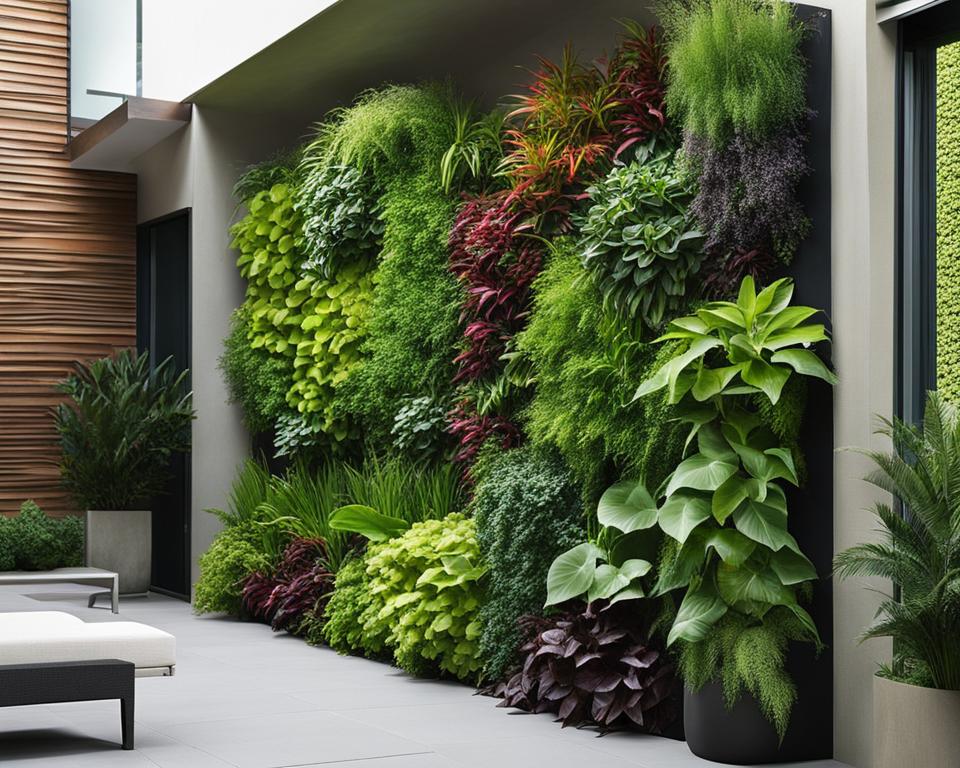
The vertical gardening design process marries form with function, paving the way for not only an attractive visual feature but also a living, breathing structure within your space. Whether your project falls under the category of vertical gardening DIY or you’re aiming to implement a professionally curated lush living wall, these design tips are crafted to guide you as you embark on your horticultural odyssey.
Incorporating Aesthetics and Functionality
Creating a vertical garden encapsulates more than just attaching plants to a wall; it’s an artful blend of aesthetic appeal and practical landscaping. Consider employing a mix of plant sizes for a layered effect, ensuring each corner of your living wall captivates the eye and contributes to a cohesive design. Symmetry can be soothing to the observer, but don’t be afraid to experiment with asymmetrical designs that can add a dynamic element to your outdoor or indoor spaces.
Matching Plants with Design Themes
When selecting plants for your vertical garden, consider the visual statement you wish to make. Is your design theme tropical paradise or a serene succulent arrangement? Maybe a vibrant edible wall is your goal. Ensure that your plant choices harmonize with your theme, as the colors and textures of the foliage will bring your design concept to life.
Lighting Techniques to Enhance Vertical Plant Displays
Proper lighting is essential for maintaining the health of your vertical garden and can significantly influence how it looks throughout the day and night. In the twilight hours, underlighting can create dramatic shadows, while spotlighting can accentuate specific plants. Incorporate energy-efficient LED lights to illuminate your living wall, and witness how it transforms into a vibrant centerpiece after dark. Here’s a table to help you combine functionality and aesthetic in a vertical garden.
| Design Element | Functionality | Aesthetic Value |
|---|---|---|
| Plant Size Variation | Caters to different root needs and growth patterns | Adds depth and visual interest |
| Symmetry in Arrangement | Structured growth pattern, efficient use of space | Presents a harmonious, balanced appearance |
| Choice of Plant Palette | Plants adapted to local climate and wall exposure | Conveys intended theme effectively |
| Integrated Lighting | Supports plant health and day/night enjoyment | Highlights textures and colors, adds drama |
Vertical Gardening DIY: Build Your Own Green Wall

Embrace the art of vertical gardening DIY and create a personal oasis with your own green wall. The journey to build a vertical garden is not just about adding greenery to your space; it’s about cultivating a living artwork that connects you to nature. Transform bare walls into vibrant landscapes with the right vertical gardening solutions, a dash of creativity, and a touch of DIY spirit.
Beginning your vertical garden is a step towards sustainable living, where each plant can contribute to cleaner air and a splash of color to your everyday life. It’s a fulfilling endeavor that requires some patience but rewards you with a lush, vertical tapestry that’s sure to be the envy of your neighborhood.
To start, gather materials that are easily accessible and fit within your budget. Common materials like marine plywood for the backing, and synthetic felt for the planting base, can be found at most hardware stores. These elements, when assembled properly, can support a variety of plants—from the delicate fronds of ferns to the hardy leaves of bromeliads. Here’s a simple guide to help you begin:
| Material | Purpose | Tips |
|---|---|---|
| Marine Plywood | Structural backing for vertical garden | Choose a thickness that supports the weight of the soil and plants when soaked |
| Synthetic Felt | Planting medium that retains moisture | Opt for a heavy-duty felt to ensure durability and proper water retention |
| Staple Gun and Staples | Securing felt to the plywood | Use stainless steel staples to prevent rust and deterioration over time |
| Landscape Fabric | Protects the wall and felt from moisture | Install behind the felt as an additional moisture barrier to protect your wall |
| Plants of Choice | Creating the living element of your garden | Select plants that fit the light and climate conditions of your garden’s location |
When selecting plants, consider the environmental conditions such as light exposure and climate. Research the plants that will flourish in your locale for a robust and resilient garden. Here’s a simple lineup of plant options that are popular among vertical gardening enthusiasts:
- Ferns for shady, moist walls
- Bromeliads for a tropical flair
- Succulents for sunny, dry spots
- Edible herbs for a kitchen garden twist
Remember, your vertical gardening project is more than just a decorative feature. It’s a thriving, growing entity that requires care and attention. Keep in mind that the key to a successful vertical garden is regular maintenance—watering, feeding, and pruning—to keep it looking fresh and vibrant throughout the seasons.
To ensure your green wall thrives, monitor it closely and adjust your care routine as needed, considering the specific needs of the plants you’ve chosen. With the right approach and dedication, your DIY vertical garden will not only beautify your space but also offer a serene green escape in the heart of your home.
Benefits of Vertical Gardening in Urban Spaces
Urban landscapes are frequently characterized by their limited ground space and the relentless quest for green sanctuaries. Vertical gardens provide not only an innovative solution to this urban constraint but also offer numerous advantages that are transforming city living.
Maximizing Limited Space with Vertical Growth
With the scarcity of space being a prominent issue in urban settings, vertical gardening systems stand out as an efficient way to utilize every inch available. Vertical gardening benefits are especially palpable in densely populated areas where the concept of a traditional garden space is simply not feasible. By turning walls, balconies, and even rooftops into verdant ecosystems, urban vertical gardening empowers city dwellers to foster nature right where they live and work.
Vertical Gardens as a Solution to Urban Air Pollution
It’s well-known that plants play a crucial role in cleaning the air, and vertical gardening amplifies this benefit. Through the process of photosynthesis, vertical gardens help filter out contaminants and carbon dioxide, delivering a breath of fresh air to pollution-laden urban environments. Not only do they aesthetically enhance the space, but they also combat air pollution—an invaluable benefit in any city landscape.
The Social and Community Impact of Vertical Green Spaces
Vertical gardens are not just structures for plants; they are also pivotal in fostering social connection and community engagement. These living installations often become community projects that bring people together, encouraging collaborative efforts towards maintaining and enjoying the green spaces. Indeed, a vertical garden can serve as a communal point, improving not only the aesthetics of the environment but also the sense of community and togetherness in urban areas.
| Aspect of Urban Vertical Gardening | Benefits |
|---|---|
| Space Efficiency | Leverages unused vertical surfaces for plant growth. |
| Air Quality | Plants in vertical gardens detoxify and oxygenate the air. |
| Heat Reduction | Helps to mitigate the urban heat island effect. |
| Biodiversity | Encourages wildlife, such as bees and birds, to inhabit urban areas. |
| Mental Wellbeing | Provides greenery that enhances mood and reduces stress levels. |
| Community Engagement | Acts as focal points for community building and educational opportunities. |
Vertical Gardening Plants and Their Environmental Impact
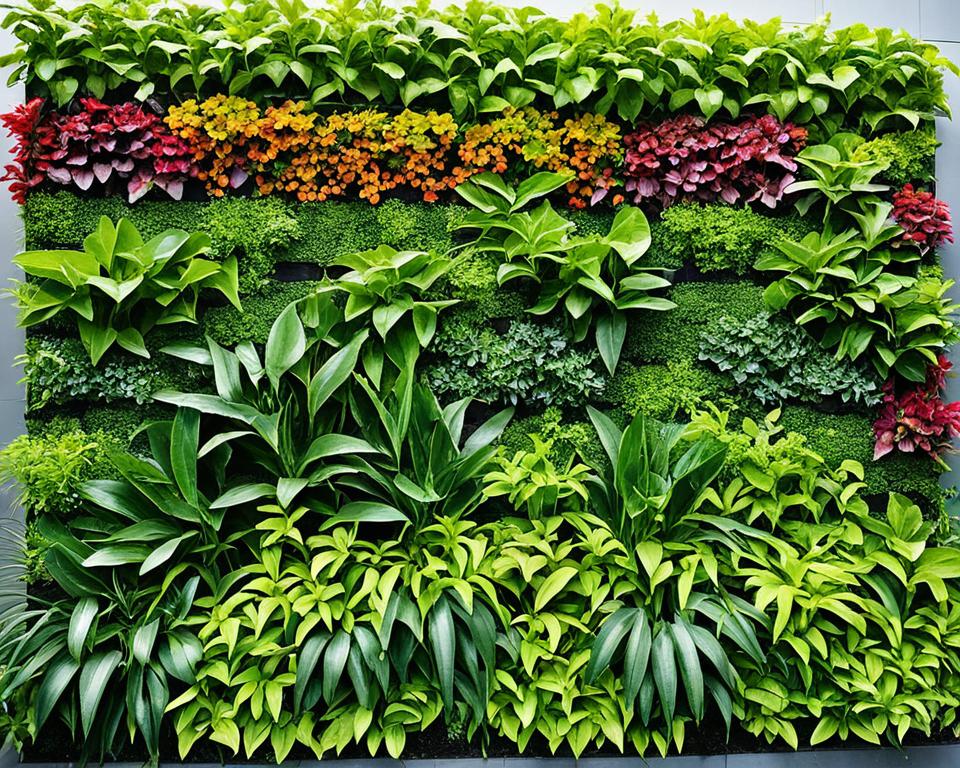
When considering vertical gardening, it’s paramount to recognize not just its aesthetic appeal, but its significant environmental impact. As urban spaces become denser, creating lush living walls serves as a beacon for environmentally conscious development, achieving beauty and ecological harmony in one stroke. A thoughtfully planned living wall does more than simply adorn a cityscape—it can actively counteract detrimental environmental effects that are often side effects of urbanization.
The environmental impact of vertical gardening spans various beneficial aspects, chief among them being the mitigation of urban heat island effects. By providing shade and transpiring water, vertical gardens cool the air, significantly lowering surrounding temperatures. Additionally, they contribute to improved air quality by acting as natural air filters, absorbing pollutants and releasing clean oxygen.
Furthermore, by incorporating diverse plant species into vertical designs, these gardens enhance biodiversity, fostering a range of habitats for urban wildlife. Birds, insects, and even small mammals find refuge amongst the greenery, turning a barren wall into a bastion of life. This cross-section of environmental benefits not only redefines the concept of urban green space but also underscores the vital role green architecture can play in crafting sustainable cities.
Let’s take a deeper look into the various environmental benefits that vertical gardens provide:
| Benefit | Description | Impact |
|---|---|---|
| Heat Reduction | Vertical gardens provide cooling through shade and evapotranspiration. | Decreased local temperatures, mitigation of heat island effect. |
| Air Purification | Plants absorb CO2 and pollutants; release oxygen. | Healthier air, reduced risk of respiratory issues. |
| Biodiversity Enhancement | Varied flora and fauna on living walls provide habitats. | Improved ecosystem health, protection of urban wildlife. |
A thriving living wall is more than just a green façade; it’s a statement that environmental friendliness and urbanization can go hand in hand. By adopting vertical gardening, you play a part in pioneering a movement towards more sustainable, vibrant, and healthful urban landscapes.
Ideas for Integrating Vertical Gardening in Small Spaces
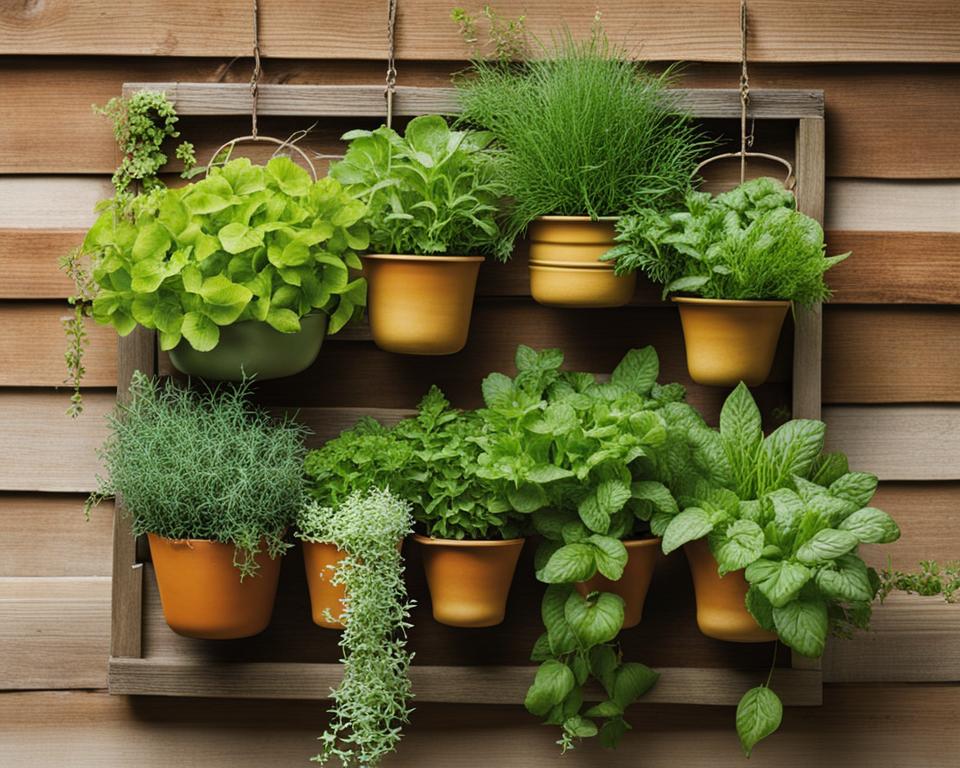
If you’re dealing with the challenge of limited ground area, vertical gardening ideas can transform your small-space environment into lush and productive green zones. Whether it’s a tiny balcony, a cramped patio, or a narrow side yard, vertical gardening offers ingenious solutions for growing plants upward, not outward. Embrace vertical gardening and watch your small-space flourish with life and color.
Using Vertical Surfaces for Herb Gardens
Cultivating your own vertical herb garden can save precious countertop space and enliven your culinary experience. Imagine plucking fresh basil, thyme, or parsley right from your kitchen wall – it’s both convenient and aesthetically pleasing. Hooks and shelves are all you need to hang small containers or repurpose pallets to create a fragrant tapestry of herbs.
Maximizing Balcony and Patio Spaces
Even the smallest balconies can accommodate vertical planters, strategically positioned to soak up sunlight without obstructing your view. Use rail-mounted pots, vertical wall planters, or hanging baskets to transform your balcony into a mini oasis. Overhead options like planters suspended from the ceiling can add another layer of greenery while maximizing the use of vertical space.
Compact Plants for Small-Scale Vertical Gardens
Selecting the right plant varieties can make all the difference in small-space vertical gardening. Opt for compact plants that thrive in vertical setups. Dwarf varieties of tomatoes, succulents, and air plants lend themselves beautifully to wall-mounted planters, requiring minimal room to grow while providing maximum visual impact.
| Plant Type | Space Requirements | Light Needs |
|---|---|---|
| Succulents | Minimal; shallow planters suffice | Bright, indirect light preferred |
| Dwarf Tomatoes | Small pots or modular planters | Full sun for 6-8 hours a day |
| Herbs (Basil, Mint, Thyme) | Can grow in vertical pouches or pockets | At least 4 hours of sunlight |
| Air Plants (Tillandsia) | No soil needed; perfect for glass globes or mesh | Indirect light; can tolerate lower light levels |
How to Ensure Healthy Growth in Your Vertical Garden
Cultivating a healthy vertical garden is akin to crafting a living masterpiece; it requires deliberate care and detailed knowledge. The secret lies in not only understanding the unique challenges but also embracing the distinct maintenance practices required for maintaining vertical gardens. Here are some practical vertical gardening tips to help ensure your green wall flourishes.
First and foremost, mastering the watering technique is essential. Unlike traditional gardening, water distribution does not occur as evenly in a vertical setup, and gravity can cause the water to run off too quickly. Implementing a drip irrigation system that delivers water to each plant individually can make an immense difference in their vigour.
Fertilizing your vertical garden warrants cautious consideration; with a limited amount of soil, precise nutrient management ensures plants remain hearty and flourishing. Look to use a balanced, water-soluble fertilizer, adjusted to the specific needs of your plants. Now, let’s explore the crucial maintenance routine that will keep your vertical beauty in peak condition:
- Regular inspection of plant health is critical—check for signs of pests, disease, and nutrient deficiencies.
- Pruning is vital not only for aesthetics but also for preventing overgrowth that can lead to poor air circulation and disease.
- Don’t overlook the importance of dusting your plants—clean leaves allow for better photosynthesis.
- Be vigilant about weeding; unwanted plants can compete with your garden for essential nutrients.
A table of routine maintenance tasks can facilitate a better understanding of what needs to be done and when:
| Task | Frequency | Purpose |
|---|---|---|
| Watering | As needed, depending on climate and plant type | Ensures consistent moisture without waterlogging |
| Fertilizing | Every 4-6 weeks | Replenishes essential nutrients |
| Pruning | Every 2-3 months or as needed | Maintains shape and promotes healthy growth |
| Dusting | Monthly | Improves photosynthesis and plant health |
| Weeding | As needed | Removes competition for nutrients and space |
| Inspection | Weekly | Early detection of potential issues |
By following these guidelines and regularly assessing your garden’s condition, your vertical oasis will not only survive but thrive, bringing beauty and vitality to your space. Remember, patience and consistency are just as important as the water and nutrients you provide.
Grow Edibles Vertically: Vegetables and Fruit Walls
Maximizing your growing space with edible vertical gardening not only elevates the aesthetics of your environment but also contributes to a sustainable lifestyle. Imagine plucking fresh tomatoes or snipping aromatic herbs directly from your living fruit walls; this is the dynamic world of vertical garden vegetables and fruits.
Edible Vertical Gardening Ideas
Vertical structures offer a unique opportunity to grow a variety of edible plants in a compact space. Think luscious strawberries hanging from baskets or robust chard peering out from modular panels. With inventive vertical gardening techniques, the possibilities are as delicious as they are endless.
- Utilize hanging pots for herbs like basil and parsley.
- Choose climbing varieties such as beans and peas for trellises.
- Grow cherry tomatoes in vertical pocket planters for easy access.
- Plant dwarf fruit trees against walls to create a living fence brimming with produce.
Choosing Fruit and Vegetable Varieties for Vertical Growth
Selecting the right species and varieties for your vertical garden ensures not just growth but also an abundant yield. Vines such as zucchini or cucumbers adapt well to vertical supports, while compact varieties of peppers and eggplants can thrive in wall-mounted systems.
| Plant Type | Best Varieties for Vertical Growth | Support Required |
|---|---|---|
| Tomatoes | ‘Tumbling Tom’, ‘Tiny Tim’ | Cages or Trellises |
| Peas | ‘Sugar Snap’, ‘Snow Pea’ | Netting or Stakes |
| Beans | ‘Blue Lake’, ‘Pole Bean’ | Poles or Towers |
| Squash | ‘Vertical Tromboncino’, ‘Butternut’ | Strong Trellis |
Ensuring Proper Nutrition for Edible Vertical Gardens
Providing the right nutrients to your edible vertical garden is as essential as choosing the right varieties. Soil quality, fertilization, and adequate watering are paramount for the health and productivity of your vertical edibles. A balanced approach with both organic compost and purpose-specific fertilizers will enrich your fruits and vegetables, resulting in a truly bountiful harvest.
- Test soil regularly to maintain optimal pH and nutrient levels.
- Implement a drip irrigation system to conserve water and ensure even distribution.
- Complement soil with organic matter such as compost to boost plant health.
- Prune and train plants to maximize air circulation and exposure to sunlight.
As you explore the world of vertical garden vegetables and fruits, let your creativity take the lead. With the application of smart vertical gardening techniques and a bit of patience, your vertical space will transform into an abundant source of homegrown edibles, enhancing both your meals and your quality of life.
Conclusion
Embarking on your vertical gardening journey means stepping into a realm where space turns into a canvas for nature’s beauty. This innovative approach to gardening not only maximizes limited areas but also injects life into urban environments, fostering a more sustainable and eco-friendly future. Whether you’re just starting or seeking to expand your green endeavors, remember that each plant on your living wall is a stroke in the masterpiece you’re painting within your space.
Summarizing the Vertical Gardening Journey
From crafting lush living walls to nurturing a crop of vertical edibles, your journey in vertical gardening has the potential to transform any space into a vibrant, flourishing ecosystem. It’s a pathway marked by creativity, efficiency, and ecological awareness. Keep in mind the light requirements, space constraints, and specific needs of your plants as you cultivate your vertical oasis, aligning closely with the pillars of eco-friendly vertical gardening.
Next Steps for Aspiring Vertical Gardeners
Aspiring vertical gardeners should embrace this venture with patience and an eagerness to learn. Start with small-scale projects to build your confidence and understanding of vertical gardening systems. As you grow more adept, your vertical gardens will proliferate, culminating in more ambitious and intricate installations. Continue to absorb knowledge, innovate, and stay attuned to the rhythms of nature as you climb the trellis of your vertical gardening aspirations.
Encouraging Eco-Friendly Practices Through Vertical Gardening
In cultivating your vertical gardens, you inherently support a greener planet. Eco-friendly vertical gardening practices help mitigate the concrete density of urban landscapes, enhancing biodiversity and contributing to a healthier atmosphere. Each green wall is a step towards an environmentally conscious lifestyle, demonstrating that in the vertical expanse, there’s not only beauty but also a resolute commitment to the well-being of our Earth.
FAQ
What are the best plants for vertical gardening?
The best plants for vertical gardening include a variety of species that perform well in a vertical environment. For sunny areas, consider vibrant annual vines like black-eyed Susan vine and moonflower, or perennials like clematis. For shaded gardens, plants like climbing hydrangea are ideal. Edibles such as fruiting vines, nasturtiums, and vertical garden vegetables like peas and tomatoes are also great for vertical gardening. Low-maintenance options such as columnar junipers can provide vertical interest without the need for support structures.
What are some vertical gardening benefits?
Vertical gardening offers numerous benefits, including the creation of lush living walls that beautify any space, improved air quality through the filtering of pollutants, and increased biodiversity by providing habitats for wildlife. It can also help mitigate the urban heat island effect and is especially advantageous in urban areas where space is at a premium. Indoor vertical gardens can add humidity to your home environment, particularly beneficial during dry months.
How do I design a vertical garden?
When designing a vertical garden, focus on a combination of aesthetics and functionality. Think about plant selection, symmetry, varying plant sizes, and color coordination. Consider integrating lighting to make the garden visually appealing day and night. Formulate design themes that might range from a natural wildflower look to a more structured approach. Don’t forget about the requirements of the plants, such as light exposure and growth habits.
What are some efficient watering solutions for vertical gardens?
Efficient watering solutions for vertical gardens may include drip irrigation systems or self-watering containers, which ensure consistent moisture without overwatering. Some vertical gardening systems also come with built-in irrigation to simplify the watering process. It’s vital to ensure that the plants receive adequate water, especially since they may dry out faster due to increased exposure to wind and light.
Can I grow vegetables in a vertical garden?
Absolutely! Many vegetables are well-suited to vertical gardens, including but not limited to climbing varieties like tomatoes, peas, pole beans, and cucumbers. Certain types of squashes and gourds can also be trained to grow vertically. Remember to provide suitable support for these plants, and consider using containers for varieties that do not naturally climb.
How do I maintain a healthy vertical garden?
To maintain a healthy vertical garden, ensure proper watering, nutrition, and plant support. Utilize appropriate fertilizers based on plant needs and the growing medium. Regular maintenance such as pruning, cleaning the leaves, checking for pests, and weeding are also key. Additionally, employing good drainage practices will prevent waterlogged roots. Regular monitoring and adjustment of your garden’s conditions will help maintain its health and vitality.
What are some DIY vertical gardening solutions?
For those interested in DIY vertical gardening, you can create a green wall using materials like marine plywood, synthetic felt, burlap, or repurposed pallets to build the structure. Use planters, pots, or specially designed pockets to house the plants. Cascading plants and climbers are excellent for creating a lush appearance. Vertical gardens can be as simple as wall-mounted planters, or as complex as modular wall systems, depending on your skill level and commitment.
What are the best locations for vertical gardens to ensure they thrive?
The best locations for vertical gardens depend on the plants’ lighting requirements and the aesthetic goals for the space. Choose spots with sufficient sunlight for plants that require it, or shaded areas for plants that thrive in less direct light. Consider visual appeal, such as placing the garden to cover unattractive walls or to serve as a backdrop for outdoor seating areas. Indoors, select locations away from drafts and with enough indirect light for your chosen plants.
How does vertical gardening impact urban environments?
Vertical gardening has a profound impact on urban environments by improving air quality, encouraging biodiversity, and reducing the heat island effect. It also promotes social engagement by creating communal green spaces and can revitalize underutilized urban areas. Vertical gardens can make buildings more energy-efficient by providing insulation and reducing the need for air conditioning.
Are vertical gardening systems suitable for indoor use?
Yes, vertical gardening systems are certainly suitable for indoor use. Many systems are specifically designed to adapt to indoor conditions, with features that help manage water delivery and contain moisture. Indoor vertical gardens can be an aesthetically pleasing way to bring nature inside and improve air quality within a space. When selecting a system for indoor use, consider factors like compatibility with your interior decor, lighting conditions, and ease of maintenance.

